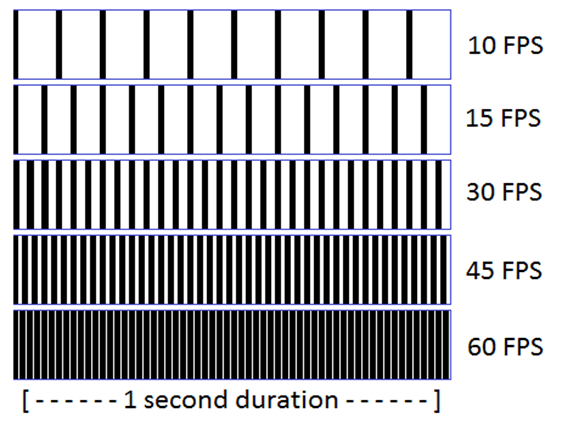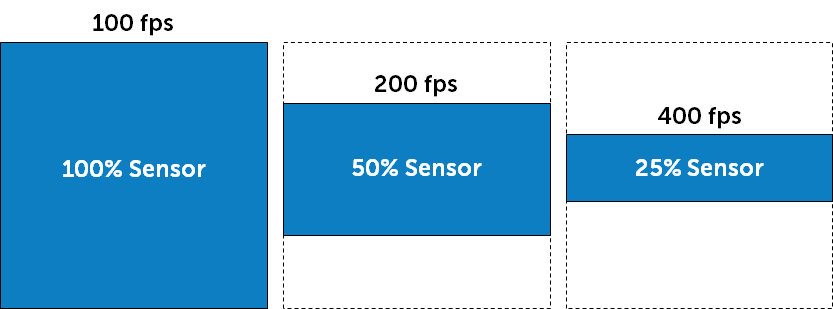Imaging Speed
Introduction
The speed of your camera can determine what samples your imaging system can detect, especially when working with live dynamic samples or techniques that image fast biological processes such as calcium imaging or voltage imaging. Even if your samples are fixed, camera speed still impacts your imaging, such as the ease at which you can pan across your sample while the image updates.
This article will discuss camera speed and the different factors that affect it, and how to get the highest speeds for your imaging.
Framerate
Camera speed can go by many names (acquisition speed, frequency, rate, etc.) but it is essentially the number of images your camera can display per second. These images are referred to as frames, and so most digital devices (such as those in phones, DSLRs, TVs, and PC monitors) measure speed in frames per second or fps. FPS can also be referred to as a frequency in Hertz (Hz), but for this document speed will be measured in FPS.
The FPS or framerate of scientific cameras has increased over time as researchers wish to image faster and more dynamic processes. While early CCDs might struggle to obtain 10 fps, a modern CMOS camera can easily achieve up to 500 fps across the full sensor. This increase in speed allows researchers to image a range of different samples that could not be captured before.
This desire for high-speed imaging in some applications leads to different methods for increasing the speed of a camera.

Figure 1: Speed measured in frames per second or FPS. The diagram shows one second of imaging,
with each vertical line representing a frame or image. At 60 fps, far more data is being obtained
than at 10 fps, allowing faster objects to be more accurately imaged.
Factors Affecting Speed
Exposure Time
The major determining factor for speed is the exposure time used. Even if you have a camera that can image at 1000 fps, if you have an exposure of 50 ms, the camera has to wait 50 ms between each frame and can therefore only image at 20 fps. In order to utilize the full speed of the camera, a lower exposure time is needed (at 1 ms exposure this camera could image at 1000 fps).
However, as mentioned in the sensitivity document, a lower exposure means less time for the camera to collect signal, meaning you may obtain high imaging speed but be unable to see your sample due to weak signals. Only with a highly sensitive camera can high speeds be obtained, as low exposures are a requirement of fast acquisition. Some applications use extremely low exposures with a very intense light source in order to image as fast as possible but at the risk of bleaching the sample. As with all camera specifications, changing one factor often affects the others.
Sensor Size
Camera speed is typically quoted as the speed the camera can achieve when imaging across the full sensor. However, if the imaging area is reduced, there are fewer pixels to digitize and the camera can operate faster. By selecting a region of interest (ROI), only this area will be imaged.
Figure 2 shows how a typical CMOS camera will double in speed every time the sensor size is halved, this is a linear relationship between image area and speed. In addition, as a CMOS uses an analogue-to-digital converter (ADC) for every column, this speed increase still happens when imaging at the full sensor width, it only matters how many rows are included. This often results in researchers imaging with high-speed letterboxes.
However, while the speed increases, the field of view that can be imaged decreases. For some experiments, this isn't an issue, and imagers can simply draw a region around their desired sample (such as a cell) and obtain high-speed imaging for this small region, also achieving a smaller file size as there are fewer pixels.

Figure 2: Changing the sensor size will change the speed, with a CMOS camera this relationship is linear
(half the sensor size, double the speed).
Readout Methods
Some scientific cameras have a variety of different modes they can image in, a popular choice being a 'Low Noise Mode' which allows the camera to operate with less read noise, increasing the sensitivity. However, these low read noise modes often come at the cost of speed. For example, while the Prime BSI Express CMOS can image at 95 fps at full frame in one mode, in the low read noise Correlated Multi Sampling (CMS) mode, the max speed is now 44 fps at full frame.
Some cameras, such as the Kinetix CMOS, offer high-speed modes to increase the speed. The Kinetix will operate at 90 fps full frame in Sensitivity mode, or 500 fps full frame in Speed mode.
If you want to prioritize speed, it is important to determine which readout modes the camera is using, and whether or not they are affecting the speed.
Digital Interfaces
The way the camera interacts with the PC is also important for the speed. The digital interfaces, or the cable used to plug the camera into the PC, comes in a wide range of options, from older obsolete interfaces such as FireWire to modern interfaces like USB and PCI Express.
Different digital interfaces will have different data rates and will be able to push different amounts of data to the PC. For example, the Iris 15 CMOS has an enormous 15 million pixels, meaning that the digital interfaces make a big difference to the data rate and the camera speed. Using an Iris 15 with USB results in a speed of 10 fps at full frame, compared to 30 fps full frame with a PCI Express cable. However, it should be noted that this is not a factor with all cameras, when using the latest firmware some cameras can achieve the same framerate with USB or PCI Express.
While USB cables have a lower data rate, the technology constantly moves forwards. USB offers a plug-and-play solution where most PCs have USB 3.0 slots and above, whereas other more specialist cables such as PCI Express require an additional card in order to be used with most PCs, and also feature other aspects like having to have the camera running before turning on the PC. Either way, it is good to know what your options are for digital interfaces with particular camera models, and which will deliver the most speed for your application.
Camera Type and Model
As outlined in our Modern Camera Technologies article, CMOS cameras are far faster than earlier camera designs such as CCDs and EMCCDs. This means that CMOS cameras are often chosen when high speeds are needed, but there is still a range of available speeds amongst CMOS cameras.
If high speeds are needed, certain camera models can deliver much higher speeds while still retaining the necessary sensitivity for good quantitative imaging. At Photometrics we continue to push the boundaries of high-speed imaging, most recently with the Kinetix CMOS, which can image at 500 fps at full frame, increasing to many 1000s at smaller regions, up to maximum speeds of ~200,000 fps!
Summary
Some biological processes occur on such a small timescale that only the fastest cameras can capture these events, this is why imaging speed and framerate are much-desired qualities in scientific cameras, with speeds increasing all the time. Fast imaging allows for the capture of never-seen-before dynamic activity, and by choosing the right camera, cables, exposures, and imaging area, you too can maximize your imaging speed and capture more than before!